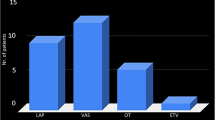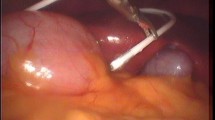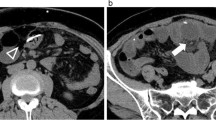Abstract
Purpose
The purpose of this study was to determine whether drainage and revision are an effective treatment for abdominal pseudocyst associated ventriculoperitoneal (VP) shunt failure by estimating the total rate of secondary shunt failure.
Methods
We performed a retrospective review of children with hydrocephalus diagnosed with and treated for an abdominal pseudocyst at the Children’s Hospital, London Health Sciences Centre (LHSC) between January 1, 2000 and May 31, 2016 (ethics approval # 108136). Patients with a VP shunt were included if (i) the development of an abdominal pseudocyst at age 2 to 18 years was identified, (ii) treatment of the pseudocyst by either interventional radiology (IR) or surgical drainage, and (iii) revision of the VP shunt. Demographic data and details of pseudocyst formation/ treatment as well as subsequent failures were identified.
Results
Twelve patients who had a VP shunt developed abdominal pseudocyst and met inclusion criteria. A 91% shunt failure rate after drainage and shunt revision was identified. Three patients had the pseudocyst drained in interventional radiology and then externalized due to shunt infection. Nine patients were treated by surgical revision. Ten patients experienced recurrent shunt failure following initial drainage of the pseudocyst: pseudocyst reoccurrence (n = 3), distal obstruction from adhesions (n = 1), and uncleared infection (n = 6).
Conclusion
The results suggest that pseudocyst drainage and shunt revision is ineffective in providing long-term resolution of shunt problems.
Similar content being viewed by others
References
Ayan E, Tanriverdi HI, Caliskan T, Senel U, Karaarslan N (2015) Intraabdominal pseudocyst developed after ventriculoperitoneal shunt: a case report. J Clin Diagn Res 9:PD05–PD06. https://doi.org/10.7860/jcdr/2015/14064.6114
Carvalho FO, Bellas AR, Guimaraes L, Salomao JF (2014) Laparoscopic assisted ventriculoperitoneal shunt revisions as an option for pediatric patients with previous intraabdominal complications. Arq Neuropsiquiatr 72:307–311
Dabdoub CB, Dabdoub CF, Chavez M, Villarroel J, Ferrufino JL, Coimbra A, Orlandi BM (2014) Abdominal cerebrospinal fluid pseudocyst: a comparative analysis between children and adults. Childs Nerv Syst 30:579–589. https://doi.org/10.1007/s00381-014-2370-2
de Ribaupierre S, Rilliet B, Vernet O, Regli L, Villemure J-G (2007) Third ventriculostomy vs ventriculoperitoneal shunt in pediatric obstructive hydrocephalus: results from a Swiss series and literature review. Childs Nerv Syst 23:527–533
Ersahin Y, Mutluer S, Tekeli G (1996) Abdominal cerebrospinal fluid pseudocysts. Childs Nerv Syst 12:755–758
Gupta N, Park J, Solomon C, Kranz DA, Wrensch M, YW W (2007) Long-term outcomes in patients with treated childhood hydrocephalus. J Neurosurg 106:334–339. https://doi.org/10.3171/ped.2007.106.5.334
Gutt CN, Oniu T, Schemmer P, Mehrabi A, Büchler MW (2004) Fewer adhesions induced by laparoscopic surgery? Surg Endosc Other Interv Tech 18:898–906. https://doi.org/10.1007/s00464-003-9233-3
Hamid R, Baba AA, Bhat NA, Mufti G, Mir YA, Sajad W (2016) Postventriculoperitoneal shunt abdominal pseudocyst: challenges posed in management. Asian J Neurosurg. https://doi.org/10.4103/1793-5482.145539
Klimo P Jr, Poppel MV, Thompson CJ, Baird LC, Duhaime A-C, Flannery AM (2014) Pediatric hydrocephalus: systematic literature review and evidence-based guidelines. Part 6: preoperative antibiotics for shunt surgery in children with hydrocephalus: a systematic review and meta-analysis. J Neurosurg Pediatr 14:44–52. https://doi.org/10.3171/2014.7.PEDS14326
Martin K, Baird R, Farmer JP, Emil S, Laberge JM, Shaw K, Puligandla P (2011) The use of laparoscopy in ventriculoperitoneal shunt revisions. J Pediatr Surg 46:2146–2150. https://doi.org/10.1016/j.jpedsurg.2011.07.001
McGirt MJ, Zaas A, Fuchs HE, George TM, Kaye K, Sexton DJ (2003) Risk factors for pediatric ventriculoperitoneal shunt infection and predictors of infectious pathogens. Clin Infect Dis 36:858–862. https://doi.org/10.1086/368191
Mobley LW 3rd, Doran SE, Hellbusch LC (2005) Abdominal pseudocyst: predisposing factors and treatment algorithm. Pediatr Neurosurg 41:77–83. https://doi.org/10.1159/000085160
Oh A, Wildbrett P, Golub R, Yu LM, Goodrich J, Lee T (2001) Laparoscopic repositioning of a ventriculo-peritoneal catheter tip for a sterile abdominal cerebrospinal fluid (CSF) pseudocyst. Surg Endosc 15:518. https://doi.org/10.1007/s004640000162
Paiva WS, Andrade AF, Mathias Junior L, Guirado VM, Amorim RL, Magrini NN, Teixeira MJ (2010) Management of supratentorial epidural hematoma in children: report on 49 patients. Arq Neuropsiquiatr 68:888–892
Paiva WSS, Amorim RLO, Figueiredo EG, Pinto FCG, Teixeira MJ (2010) Management of the ventriculoperitoneal shunt infections. Revista Panamericana de Infectología 12:43–47
Pernas JC, Catala J (2004) Case 72: pseudocyst around ventriculoperitoneal shunt. Radiology 232:239–243. https://doi.org/10.1148/radiol.2321011976
Rekate HL (2000) Hydrocephalus: classification and pathophysiology. In: McLone D (ed) Pediatric neurosurgery: surgery of the developing nervous system. W.B. Saunders, Philadelphia
Roitberg BZ, Tomita T, McLone DG (1998) Abdominal cerebrospinal fluid pseudocyst: a complication of ventriculoperitoneal shunt in children. Pediatr Neurosurg 29:267–273
Salomao JF, Leibinger RD (1999) Abdominal pseudocysts complicating CSF shunting in infants and children. Report of 18 cases. Pediatr Neurosurg 31:274–278
Sanal M, Laimer E, Haussler B, Hager J (2007) Abdominal cerebrospinal fluid pseudocysts in patients with ventriculoperitoneal shunts: 30 years of experience*. J Indian Assoc Pediatr Surg 12:214–217. https://doi.org/10.4103/0971-9261.40838
Santos de Oliveira R, Barbosa A, Vicente YMAAV, Rubens Machado H (2007) An alternative approach for management of abdominal cerebrospinal fluid pseudocysts in children. Childs Nerv Syst 23:85–90. https://doi.org/10.1007/s00381-006-0183-7
Scherer A, Kaefer M, Ackerman L (2014) Severe hydronephrosis caused by an infected intra-abdominal fluid collection in a patient with a ventriculoperitoneal shunt. Childs Nerv Syst 30:1121–1123. https://doi.org/10.1007/s00381-013-2322-2
Shah HC, Mittal DH, Shah JK (2015) Abdominal cerebrospinal fluid pseudocysts in children: a complication of ventriculoperitoneal shunt. Indian. J Neurosurg 4:049–051
Sharifa A-D (2014) Ventriculoperitoneal shunt with communicating peritoneal & subcutaneous pseudocysts formation. Int J Health Sci 8:107–111
Simon TD, Hall M, Riva-Cambrin J, Albert JE, Jeffries HE, Lafleur B, Dean JM, Kestle JR (2009) Infection rates following initial cerebrospinal fluid shunt placement across pediatric hospitals in the United States. J Neurosurg Pediatr 4:156–165. https://doi.org/10.3171/2009.3.PEDS08215
Stein SC, Guo W (2008) Have we made progress in preventing shunt failure? A critical analysis. J Neurosurg Pediatr 1:40–47. https://doi.org/10.3171/PED-08/01/040
Stone JJ, Walker CT, Jacobson M, Phillips V, Silberstein HJ (2013) Revision rate of pediatric ventriculoperitoneal shunts after 15 years. J Neurosurg Pediatr 11:15–19. https://doi.org/10.3171/2012.9.PEDS1298
Tamber MS, PK J, Mazzola CA, Flannery AM (2014) Pediatric hydrocephalus: systematic literature review and evidence-based guidelines. Part 8: management of cerebrospinal fluid shunt infection. J Neurosurg Pediatr 14:60–71. https://doi.org/10.3171/2014.7.PEDS14328
Tomiyama A, Harashina J, Kimura H, Ito K, Honda Y, Yanai H, Iwabuchi S (2014) An intra-abdominal pseudocyst around a ventriculoperitoneal shunt due to streptococcus infection 7 years after shunt surgery. Surg Res Pract 2014. https://doi.org/10.1155/2014/898510
Tuli S, Tuli J, Drake J, Spears J (2004) Predictors of death in pediatric patients requiring cerebrospinal fluid shunts. J Neurosurg 100:442–446. https://doi.org/10.3171/ped.2004.100.5.0442
Vinchon M, Fichten A, Delestret I, Dhellemmes P (2003) Shunt revision for asymptomatic failure: surgical and clinical results. Neurosurgery 52:347–353 discussion 353-346
Wang B, Hasadsri L, Wang H (2012) Abdominal cerebrospinal fluid pseudocyst mimicking full-term pregnancy. J Surg Case Rep 2012:6–6. https://doi.org/10.1093/jscr/2012.7.6
Wu Y, Green NL, Wrensch MR, Zhao S, Gupta N (2007) Ventriculoperitoneal shunt complications in California: 1990 to 2000. Neurosurgery 61:557–562; discussion 562-553. https://doi.org/10.1227/01.NEU.0000290903.07943.AF
Yamashita K, Yonekawa Y, Kawano T, Ihara I, Taki W, Kobayashi A, Handa Y, Kaku Y (1990) Intra-abdominal cyst following revision of ventriculoperitoneal shunt--case report. Neurol Med Chir (Tokyo) 30:748–752
Yuh S-J, Vassilyadi M (2012) Management of abdominal pseudocyst in shunt-dependent hydrocephalus. Surg Neurol Int 3:146. https://doi.org/10.4103/2152-7806.103890
Author information
Authors and Affiliations
Corresponding author
Ethics declarations
Conflict of interest
On behalf of all authors, the corresponding author states that there is no conflict of interest.
Rights and permissions
About this article
Cite this article
Dzongowski, E., Coriolano, K., de Ribaupierre, S. et al. Treatment of abdominal pseudocysts and associated ventricuoperitoneal shunt failure. Childs Nerv Syst 33, 2087–2093 (2017). https://doi.org/10.1007/s00381-017-3609-5
Received:
Accepted:
Published:
Issue Date:
DOI: https://doi.org/10.1007/s00381-017-3609-5




